American Journal of Plant Sciences
Vol.4 No.1(2013), Article ID:27615,6 pages DOI:10.4236/ajps.2013.41009
The Potato Late Blight Caused by Phytophthora infestans Mont de Bary as Selection Factor of Phurejas Potatoes (Solanum phureja Juz et Buk) in Endemic Areas of the Bolivian Andes
![]()
1Departamento de Fitotecnia y Producción Vegetal, Facultad de Ciencias Agrícolas, Pecuarias, Forestales y Veterinarias “Dr. Martin Cárdenas”, Universidad Mayor de San Simón, Cochabamba, Bolivia; 2Programa de Asistencia a la Seguridad Alimentaria, La Paz, Bolivia.
Email: *cocamorante.mario@gmail.com
Received October 5th, 2012; revised November 7th, 2012; accepted December 15th, 2012
Keywords: Apparent Infection Rate; Genetic Erosion; Late Blight
ABSTRACT
Phurejas potatoes (Solanum phureja Juz et Buk) are cultivated in very restricted areas of the Bolivian Andes. Late blight caused by Phytophthora infestans is a destructive, endemic disease that affects the survival and cultivation of this crop. The aim of this study was to determine the resistance characteristics of phurejas potato varieties to P. infestans in a traditional area of cultivation. An experimental plot was prepared in the locality of Chojchoni (3200 m) and planted with different phurejas varieties: 1) Chojllu Phureja (Sste); 2) Phureja Amarilla (Sphu); 3) Polo Phureja (Sphu); 4) Phureja Roja (Sphu); 5) Phureja Negra (Sphu) and 6) Waych’a Paceña (Sadg), a susceptible control. Severity was assessed according to the criteria of the Centro Internacional de la Papa, determining the area under the disease progress curve (AUDPC). Regression analysis (logN disease severity against time) was performed using the logistic model [ln(y/1 − y)] to determine infection rates. The different varieties showed different levels of resistance. The disease progress curve, the AUDPC and the linear regression results revealed the varieties Chojllu Phureja, Phureja Amarilla and Polo Phureja to likely have larger copy numbers of minor resistance genes against P. infestans than Phureja Roja or Phureja Negra. Late blight caused by P. infestans could cause the long-term loss of some phurejas varieties through farmers selecting others less severely affected by the disease.
1. Introduction
Phurejas potatoes (Solanum phureja Juz et Buk) are grown in the Provinces of Larecaja, Camacho, Muñecas and Bautista Saavedra in the north of the Dept. of La Paz in the Bolivian Andes. These areas lie between altitudes of 3200 and 4000 m, their soils rich in organic matter. Their climates are strongly influenced by the La Paz Mountains and range from cold to temperate, although all have high humidity and suffer permanent cloudiness. Cárdenas [1] indicated phurejas potatoes to come from Ilabaya, close to Sorata, and from the Yungas highlands in the Chojlla region (highlands of the Yungas, Dept. of La Paz). These varieties are characterized by their early nature and culinary quality [2], and are very popular with consumers in urban markets. According to Hawkes and Hjerting [3], and to Ochoa [4], the greatest diversity of S.
phureja is found in the Dept. of La Paz.
The climatic conditions of the areas where these potatoes grow are favourable to the development of late blight (known locally as “Llejte”, an Aymarian native language word) caused by the endemic Oomycete Phytophthora infestans. However, farmers need to use very little fungicide or none at all, for acceptable yields of phurejas potatoes to be obtained. Under the same conditions, other native varieties such as S. tuberosum subsp. andigena var. Waych’a Paceña, and introduced varieties such as S. tuberosum var. Desiree, require intense fungicide treatment for acceptable production to be obtained. Cañizares and Forbes [2] indicate partial resistance to late blight to be one of the characteristics of phurejas potatoes. Indeed, certain varieties of S. phureja, along with varieties of S. tuberosum subsp. andigena other than var. Waych’a Paceña, are currently being used as genetic sources of durable resistance in potato breeding programmes [3,5]. Understanding the incidence and severity of late blight over the year is of great importance for its control and the development of disease management strategies [6]. The aim of the present study was to assess the resistance of phurejas potatoes to P. infestans in a traditional area of cultivation.
2. Materials and Methods
2.1. Plant Materials
The experimental plants used in this work were five varieties of phurejas potatoes: 1) Polo Phureja (Solanum phureja-Sphu); 2) Phureja Roja (Solanum phureja-Sphu); 3) Chojllu Phureja (Solanum stenotonum-Sstn, a non Solanum phureja variety); 4) Phureja Negra (Solanum phureja-Sphu); 5) Phureja Amarilla (Solanum phureja-Sphu), plus 6) S. tuberosum subsp. andigena var. Waych’a Paceña (Sadg), a control susceptible to P. infestans. All the phurejas potatoes were collected in the locality of Chojchoni-Sorata, where they are a traditional crop and where P. infestans is endemic.
2.2. Field Experiment
An experimental plot was set up in the area of Chojchoni (3200 m, on the Warisata-Sorata road) in the Province of Larecaja, Department of La Paz (15˚52'S, 68˚38'W, 120 km from the city of La Paz). The plot was planted following a completely randomised block design with six treatments and three replicates. The treatments were the five phurejas varieties mentioned above plus the susceptible control Waych’a Paceña (Figure 1). Cypermethin was used to control Premnotrypes and Epitrix. Ridomil MZ was applied to the plants at emergence to remove any naturally occurring P. infestans before the experimental infection of the plants. Chemical (80-120-00 kg/h) and organic fertilizer (Approx. 10 t/h) were applied at the time of planting, according to traditional practices. Tubers (N = 16) were planted in rows 5 m long, with 0.7 m between rows and 0.3 m between plants. The trial was performed in summer (November-April) during the peak time of P. infestans activity.
2.3. Inoculum
After emergence the plants were sprayed with 8 × 105 sporangia/ml of P. infestans collected from infected leaflets of Phureja Negra plants growing in the same locality.
2.4. Evaluation of Late Blight and Statistical Analysis
Severity of infection was recorded on the Centro Internacional de la Papa (CIP) scale at 7-day intervals, beginning 101 days after planting, with 7 readings per treatment. A disease progress curve (DPC) was constructed according to Campbell and Madden [2]. The
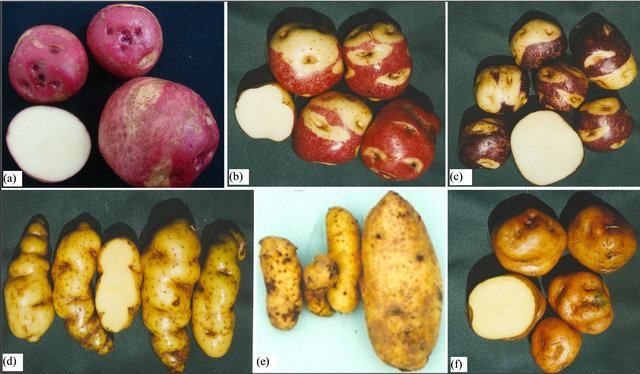
Figure 1. The potato varieties used in the present work. (a) Waych’a Paceña (Solanum tuberosum subsp. andigena, the susceptible control variety); (b) Phureja Roja (S. phureja); (c) Phureja Negra (S. phureja); (d) Chojllu Phureja (S. stenotonum); (e) Polo Phureja (S. phureja); (f) Phureja Amarilla (S. phureja).
area under the disease progress curve (AUDPC) was estimated as , where n is the number of evaluations, yi is the disease severity, and t is the time (in days) post-inoculation [2]. Infection rates (r) were modelled according to Campbell and Madden [2], and the regression coefficients (R2) determined using the logistic model [ln(y/1 − y)] [6]. Yields were estimated as kg/plant and as t/h of healthy and P. infestans-rotted tubers.
, where n is the number of evaluations, yi is the disease severity, and t is the time (in days) post-inoculation [2]. Infection rates (r) were modelled according to Campbell and Madden [2], and the regression coefficients (R2) determined using the logistic model [ln(y/1 − y)] [6]. Yields were estimated as kg/plant and as t/h of healthy and P. infestans-rotted tubers.
3. Results
3.1. Disease Progress Curve and Area under the Disease Progress Curve
The Waych’a Paceña plants showed a disease severity of 70% within 35 days, while the phurejas potatoes fell into two severity groups, one with scores similar to the control (Chojllu Phureja, Phureja Amarilla and Polo Phureja), and the other with much lower scores (Phureja Roja and Phureja Negra) (Figure 2(a)). The AUDPC for the phurejas potatoes also fell into two groups, one formed by the varieties Chojllu Phureja, Phureja Amarilla and Polo Phureja plus the control Waych’a Paceña, and the other formed by Phureja Roja and Phureja Negra (F0.05).
3.2. Disease Progress Curve: Linear Regression Analysis
The linear regressions for the phurejas potatoes were different (Figure 3), though all returned high regression coefficients (R2 > 0.9). The varieties Chojllu Phureja (r = 0.074/day), Phureja Amarilla (r = 0.067 day) and Polo Phureja (r = 0.077 day) showed infection rates below that of the control (0.085 day). That of Phureja Negra (r = 0.079 day) was also smaller, while Phureja Roja showed an infection rate equal to that recorded for the control (r = 0.085 day) (Figure 3).
3.3. Yield (t·ha−1)
Yields (t/ha) differed significantly between the different varieties (F0.01) (Figure 4(a)). The yield of Phureja Roja (7.5 t/ha) was significantly greater than those of all the other varieties. No significant difference was seen between the yields of Polo Phureja (6.38 t/ha) and Phureja Negra (6.3 t/ha), but both produced significantly higher yields than Phureja Amarilla (4.4 t/ha) and Chojllu Phureja (3.2 t/ha). In fact, the yields of these last two varieties were smaller than that recorded for the control variety (5.6 t/ha).
4. Discussion
The resistance to late blight shown by phurejas potatoes
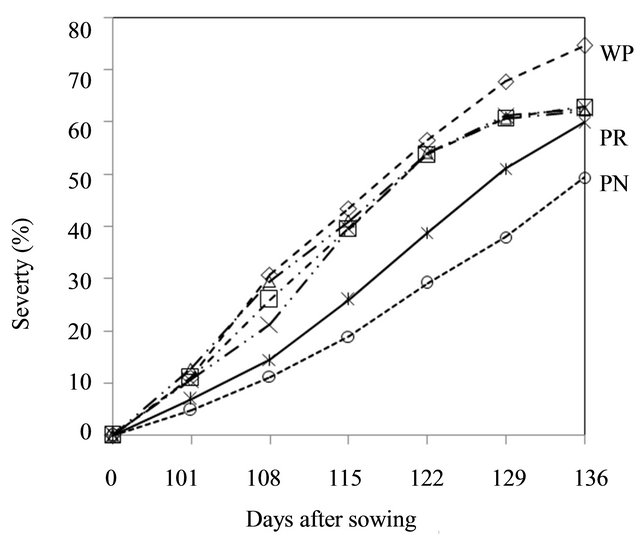 (a)
(a) (b)
(b)
Figure 2. (a) Late blight diseases severity for the five phurejas potato varieties (PR = Phureja Roja; PN = Phureja Negra) and the susceptible control variety (WP = Waych’a Paceña); (b) The AUDPCs for the different varieties were significantly different (F0.05).
is currently being used in potato breeding programmes [2,3,5]. However the present work shows that different phurejas varieties have different levels of resistance. The phenological stage of the crop also seems to influence the development of the disease. In Chojllu Phureja, Phureja Amarilla and Polo Phureja, the disease began at the same time as in the Waych’a Paceña controls, but at 122 days after inoculation disease severity began to decline in these phureja varieties, as shown by their DPCs (Figure 3(a)). This determined a similar behaviour for the corresponding AUDPCs (Figure 3(b)) and probably explains the lower infection rates seen in these varieties than in the control (Figures 4(a)-(c)). Figures 3(a) and (b)
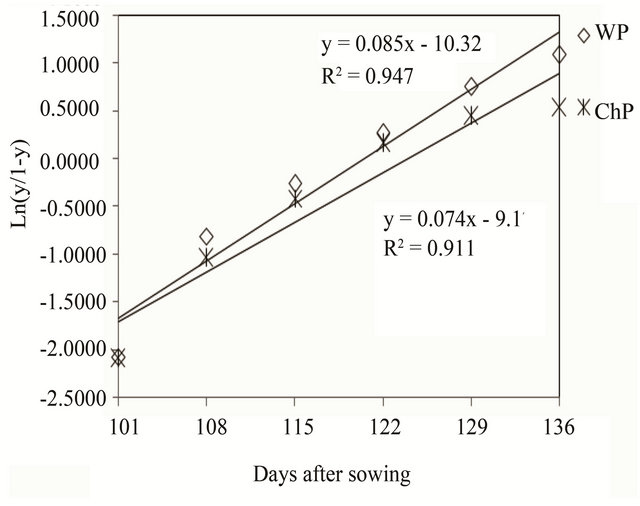 (a)
(a)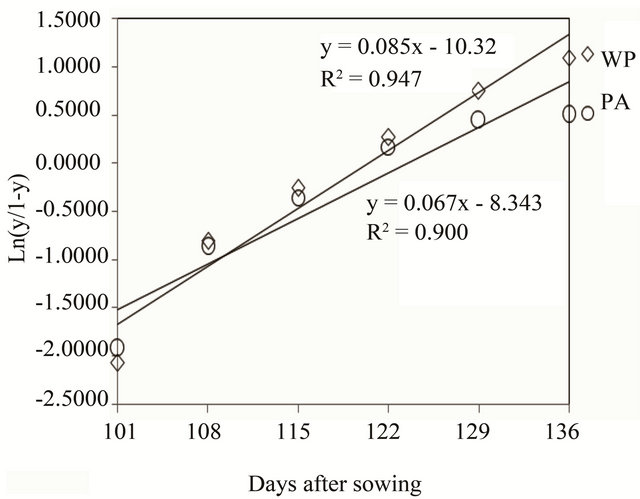 (b)
(b)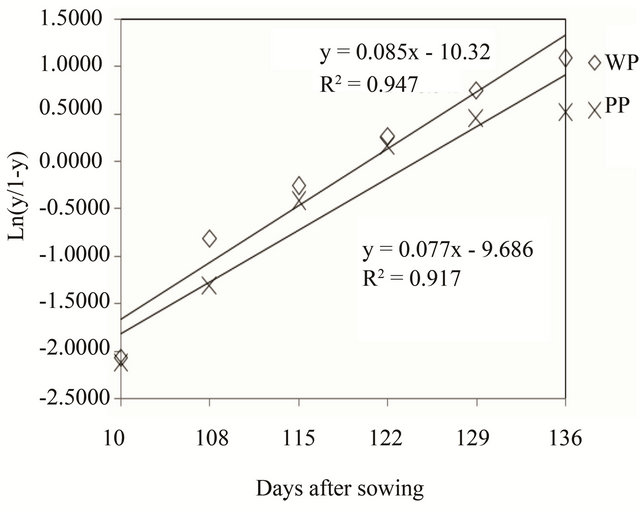 (c)
(c)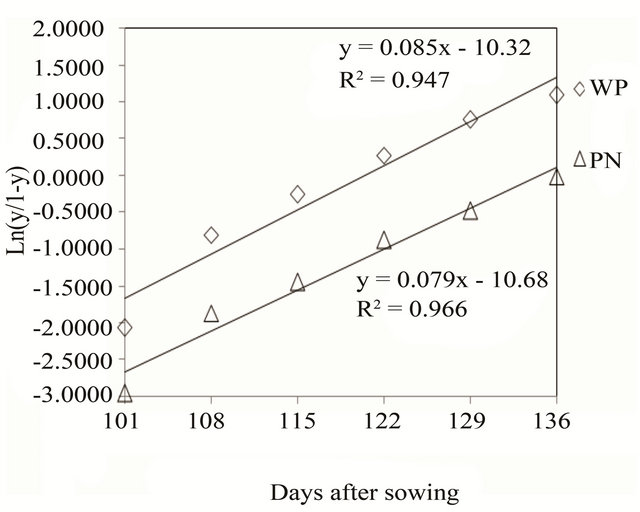 (d)
(d)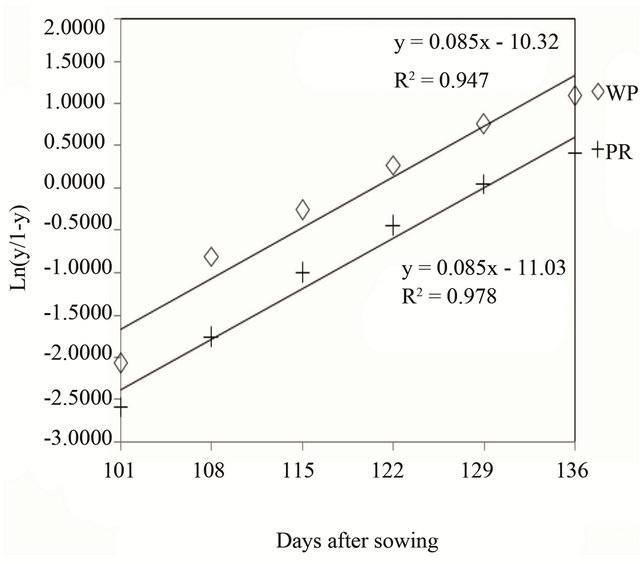 (e)
(e)
Figure 3. Linear regression of log-transformed diseases severity data for P. infestans infection against time (WP = Waych’a Paceña; PN = Phureja Negra; PR = Phureja Roja; PP = Polo Phureja; PA = Phureja Amarilla; ChP = Chojllu Phureja).
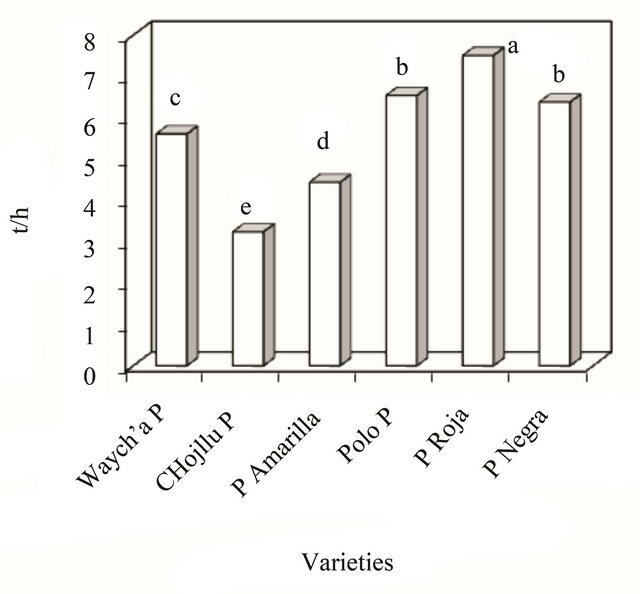 (a)
(a)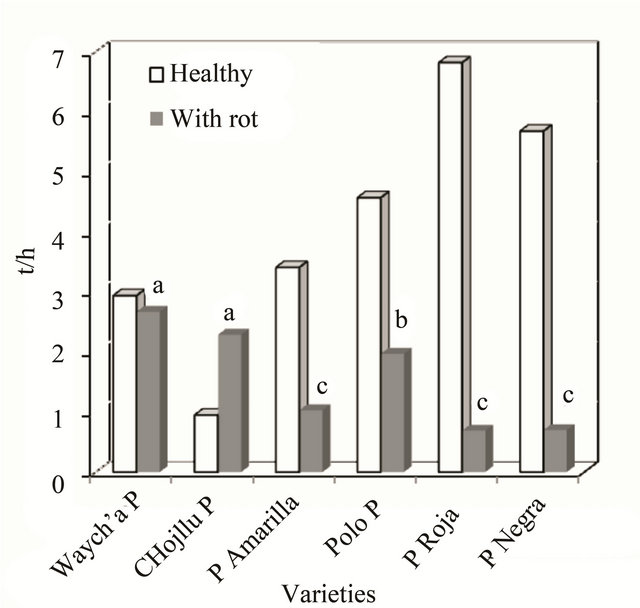 (b)
(b)
Figure 4. (a) Potato yields (t/h); (b) Healthy and rotted tuber production.
reveal the somewhat greater resistance of Phureja Roja and Phureja Negra, although towards the end of the experimental period disease severity appeared to increase.
In Bolivia, Waych’a Paceña is susceptible to late blight. In the traditional areas of seed potato production (Independencia, Morochata, Lope Mendoza and Colomi) in the Dept. of Cochabamba, and in other areas of the Depts. of Chuquisaca and Tarija, endemic late blight has to be controlled via eight or more application of fungicide. In contrast, phurejas potatoes are usually grown in their traditional areas without the need for such protecttion.
Linear regression analysis (logN disease severity against time) allows the infection rate during an epidemic to be determined [6-8]. The infection rates for Chojllu Phureja, Phureja Amarilla, Polo Phureja and Phureja Negra suggest these varieties possess partial resistance to late blight, while Phureja Roja appears to be as susceptible to the disease as the Waych’a Paceña controls.
The yield of the phurejas varieties was closely related to their level of resistance. Cañizares and Forbes [2] reported low AUDPC values and acceptable mean yields to indicate the possession of minor resistance genes. The high AUDPC values and low yields shown by Chojllu Phureja and Phureja Amarilla in the present work might therefore be a sign of their low copy numbers of late blight resistance genes. The level of tuber rot also varied from one phurejas variety to another, with Phureja Roja and Phureja Negra most affected, and Chojllu Phureja, Phureja Amarilla and Polo Phureja least affected.
In the study area (Sorata), farmers preferentially raise Phureja Negra and Phureja Roja potatoes since they provide them with greater yields. The cultivation of Chojllu Phureja, Phureja Amarilla and Polo Phureja is shrinking strongly; indeed it is quite uncommon for them to be planted. As the present results show, Chojllu Phureja is strongly affected by P. inefstans, thus it is among the varieties least preferred by farmers. In the mid-long term, artificial selection forced by late blight could lead to the disappearance of the most susceptible varieties.
5. Acknowledgements
The authors are grateful to Jose Ignacio Ruiz de Galarreta, principal investigator at the Dpto. de Produccion y Proteccion Vegetal, Centro Arkaute for valuable comments and suggestions, and to the farmers of Chojchoni locality in the Province of Larecaja for their collaboration. The authors also thank Adrian Burton for editorial assistance.
REFERENCES
- M. Cárdenas, “Manual de Plantas econÓmicas de Bolivia,” 2da Edición, Editorial Los Amigos del Libro, La Paz, 1989, pp. 65-68.
- C. A. Cañizares and G. A. Forbes, “Foliage Resistance to Phytophthora infestans Mont de Bary in the Ecuadorian National Collection of Solanum phureja ssp. phureja Juz. & Buk,” Potato Research, Vol. 38, No. 1, 1995, pp. 3-10. doi:10.1007/BF02358063
- J. G. Hawkes and J. P. Hjerting, “The Potatoes of Bolivia: Their Breeding Value and Evolutionary Relationships,” Oxford University Press, Oxford, 1989, pp. 345-346.
- C. Ochoa, “The Potatoes of South America: BOLIVIA,” Cambridge University Press, Cambridge, New York, 1990, pp. 355-357.
- J. I. Ruiz de Galarreta, A. Carrasco, A. Salazar, I. Barrena, E. Iturritxa, R. Marquez, F. J. Legorboru and E. Ritter, “Wild Solanum Species as Resistance Sources against Different Pathogens of Potato,” Potato Research, Vol. 41, No. 1, 1998, pp. 57-68. doi:10.1007/BF02360262
- A. van Maanen and X.-M. Xu, “Modelling Plant Disease Epidemics,” European Journal of Plant Pathology, Vol. 109, No. 7, 2003, pp. 669-682. doi:10.1023/A:1026018005613
- L. V. Madden, G. Hughes and F. van den Bosch, “The Study of Plan Disease Epidemic,” The American Phytopathological Society, St. Paul, 2007, pp. 86-88.
- C. L. Campbell and L. V. Madden, “Introduction to Plant Disease Epidemiology,” Wiley, New York, 1990, pp. 128-132.
NOTES
*Corresponding author.

